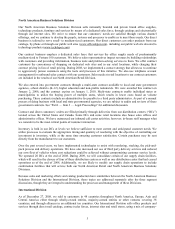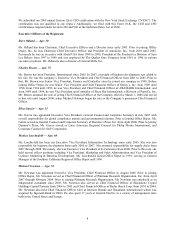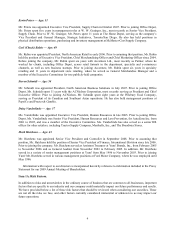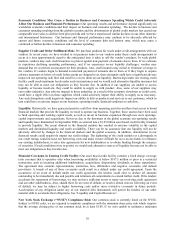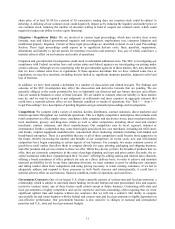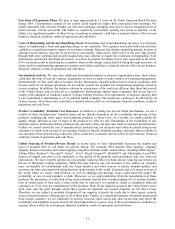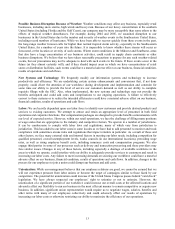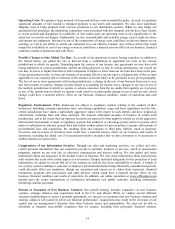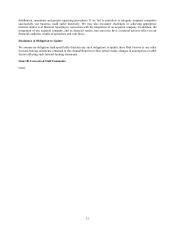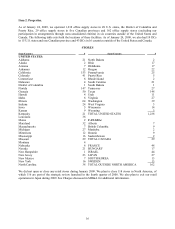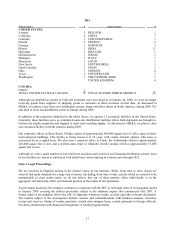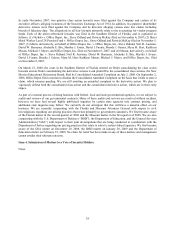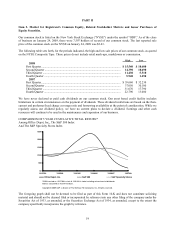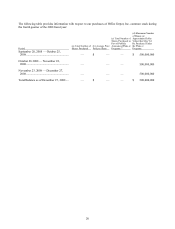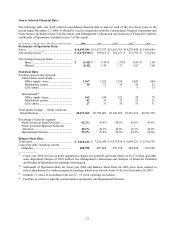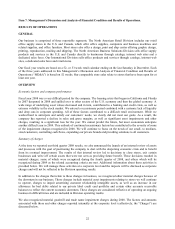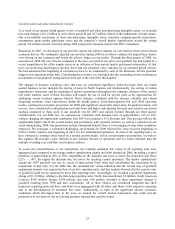Office Depot 2008 Annual Report Download - page 14
Download and view the complete annual report
Please find page 14 of the 2008 Office Depot annual report below. You can navigate through the pages in the report by either clicking on the pages listed below, or by using the keyword search tool below to find specific information within the annual report.13
Possible Business Disruption Because of Weather: Weather conditions may affect any business, especially retail
businesses, including snow storms, high winds and heavy rain. Because of our heavy concentration in the southern
United States (including Florida and the Gulf Coast), our company may be more susceptible than some others to the
effects of tropical weather disturbances. For example, during 2004 and 2005, we sustained disruption to our
businesses in the United States due to the number and severity of weather events in the Southeastern United States,
including record numbers of hurricanes. While we have been able to recover quickly from these events in the past,
the long-range weather forecast calls for higher than normal tropical storm activity, especially in the Southeastern
United States, for a number of years into the future. It is impossible to know whether these storms will occur as
forecasted, or the location or severity of such storms. Winter storm conditions in the Midwest and Southwest, areas
that also have a large concentration of our business activities, could result in supply chain constraints or other
business disruptions. We believe that we have taken reasonable precautions to prepare for any such weather-related
events, but our precautions may not be adequate to deal with such events in the future. If these events occur in the
future (as they almost certainly will), and if they should impact areas in which we have concentrations of retail
stores or distribution facilities, such events could have a material adverse effect on our business, financial condition,
results of operations and cash flows.
New Systems and Technology: We frequently modify our information systems and technology to increase
productivity and efficiency. We are undertaking certain system enhancements and conversions that, if not done
properly, could divert the attention of our workforce during development and implementation and constrain for
some time our ability to provide the level of service our customers demand as well as our ability to complete
requisite filings with the SEC. Also, when implemented, the new systems and technology may not provide the
benefits anticipated and could add costs and complications to our ongoing operations. A failure to effectively
convert to these systems or to realize the intended efficiencies could have a material adverse effect on our business,
financial condition, results of operations and cash flows.
Labor: We are heavily dependent upon our labor force to identify new customers and provide desired products and
services to existing customers. We attempt to attract and retain an appropriate level of personnel in both field
operations and corporate functions. Our compensation packages are designed to provide benefits commensurate with
our level of expected service. However, within our retail operations, we face the challenge of filling many positions
at wage scales that are appropriate to the industry and competitive factors. We operate in a number of jurisdictions.
It can be cumbersome to comply with labor laws and regulations, many of which vary from jurisdiction to
jurisdiction. This has added to our labor costs in some locales as we have had to add personnel to monitor and track
compliance with sometimes arcane rules and regulations that impact retailers in particular. As a result of these and
other factors, we face many external risks and internal factors in meeting our labor needs, including competition for
qualified personnel, overall unemployment levels, works councils (in our international locations), prevailing wage
rates, as well as rising employee benefit costs, including insurance costs and compensation programs. We also
engage third parties in some of our processes such as delivery and transaction processing and these providers may
face similar issues. Changes in any of these factors, including especially a shortage of available workforce in the
areas in which we operate, could interfere with our ability to adequately provide services to customers and result in
increasing our labor costs. Any failure to meet increasing demands on securing our workforce could have a material
adverse effect on our business, financial condition, results of operations and cash flows. In addition, changes in the
process for our employees to join a union could disrupt our business and add costs.
Unionization: While our management believes that our employee relations are good, we cannot be assured that we
will not experience pressure from labor unions or become the target of campaigns similar to those faced by our
competitors. The potential for unionization could increase if the United States Congress passes federal “card check”
legislation. We have always respected our employees’ right to unionize or not to unionize. However, the
unionization of a significant portion of our workforce could increase our overall costs at the affected locations and
adversely affect our flexibility to run our business in the most efficient manner to remain competitive or acquire new
business. In addition, significant union representation would require us to negotiate wages, salaries, benefits and
other terms with many of our employees collectively and could adversely affect our results of operations by
increasing our labor costs or otherwise restricting our ability to maximize the efficiency of our operations.


